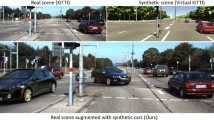Abstract
Target To construct a method for generating object detection dataset based on the virtual environment. The generated dataset can be used for object detection tasks based on deep learning algorithms. Methods The procedural generation method was used to create the city's virtual environment, and also computer graphics were used for rendering and automatic labeling. Results We constructed a virtual reality environment and collected 1500 images through the virtual environment, including 1307 images containing valid vehicle and pedestrian information, and trained a deep learning model based on this dataset. Conclusions A virtual reality environment is successfully created, and the generated dataset can be used to train deep learning object detection algorithms, and the trained models can also effectively perform object detection in real world.
Access this chapter
Tax calculation will be finalised at checkout
Purchases are for personal use only
Similar content being viewed by others
References
Zhu Y, Urtasun R, Salakhutdinov R (2015) segDeepM: exploiting segmentation and context in deep neural networks for object detection. In: 2015 IEEE conference on computer vision and pattern recognition (CVPR). IEEE
Arcuri A, Briand L (2014) A hitchhiker’s guide to statistical tests for assessing randomized algorithms in software engineering. Softw Test Verification and Reliab 24(3):219–250
Torralba A, Fergus R, Freeman WT (2008) 80 million tiny images: a large dataset for nonparametric object and scene recognition. IEEE Trans Software Eng 30(11):1958–1970
Togelius J, Champandard AJ, Lanzi PL, Mateas M, Paiva A, Preuss M, Stanley KO () Procedural content generation: goals, challenges and actionable steps
Tian J, Qingsong HE, Yan F (2014) Formalization and new algorithm of STROKE generation in road networks. Geomat Inf Sci Wuhan Univ 39(5):556–560
Li R, Li P, Zhang X et al (2003) Optimization of hierarchical details in virtual environment modeling. Comput Simul 20(1):73–75
Perez L, Wang J (2017) The effectiveness of data augmentation in image classification using deep learning. ar**v preprint ar**v:1712.04621
Andaluz VH, Sánchez JS, Chamba JI et al (2016) Unity3D virtual animation of robots with coupled and uncoupled mechanism. Augmented Reality, Virtual Reality, and Computer Graphics
Qi CR, Su H, Mo K et al (2017) Pointnet: deep learning on point sets for 3D classification and segmentation. In: Proceedings of the IEEE conference on computer vision and pattern recognition, pp 652–660
Author information
Authors and Affiliations
Corresponding author
Editor information
Editors and Affiliations
Rights and permissions
Copyright information
© 2020 The Editor(s) (if applicable) and The Author(s), under exclusive license to Springer Nature Singapore Pte Ltd.
About this paper
Cite this paper
Ding, P., Shen, Q., Huang, T., Wang, M. (2020). A Generation Method and Verification of Virtual Dataset. In: Long, S., Dhillon, B.S. (eds) Man-Machine-Environment System Engineering. MMESE 2020. Lecture Notes in Electrical Engineering, vol 645. Springer, Singapore. https://doi.org/10.1007/978-981-15-6978-4_55
Download citation
DOI: https://doi.org/10.1007/978-981-15-6978-4_55
Published:
Publisher Name: Springer, Singapore
Print ISBN: 978-981-15-6977-7
Online ISBN: 978-981-15-6978-4
eBook Packages: Computer ScienceComputer Science (R0)




